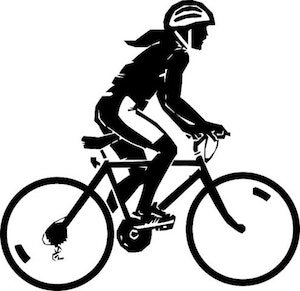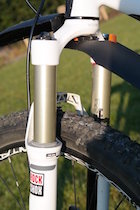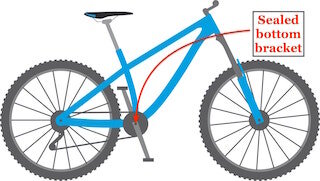Cycling is one of the best ways to maintain lean muscle, while also shedding abdominal fat when riding in a HIIT-style.
While you can’t just ‘spot reduce’ or control precisely where your fat will come off, there are workouts that are more effective at reducing the circumference of your waist.
“Weight loss induced by increased daily physical activity without caloric restriction substantially reduces obesity (particularly abdominal obesity)”
HIIT, cycling & fat loss
“A recent systemic review has concluded that low intensity exercise training is less effective in reducing body fat than moderate to high intensity exercise training ”
High-Intensity Interval Training or HIIT is the most effective form of exercise for fat loss, including fat around your midsection.
So what exactly is HIIT?
High-Intensity Interval Training is anaerobic by nature, as you alternate between short bursts of intense cycling followed by periods of easy pedaling (active recovery).
HIIT is the complete OPPOSITE of the typical low to moderate-intensity aerobic training regimens that most ‘fitness experts’ advocate.
Walking/jogging or cycling at a slow/moderate steady pace are examples of cardiovascular training and are NOT high-intensity training.
Cycling is HIIT
Cycling with all-out effort for maximum power and speed, especially when you encounter hills. Followed by periods of active rest, such as coasting downhills and flat sections is an example of how you can turn cycling into a HIIT activity where you can actually burn off the unwanted abdominal fat.
When you cycle all out, you’re breaking down your muscles, which means that you will need additional rest and recovery to regenerate your muscle cells. HIIT programs are more akin to resistance training regimes than traditional cardio.
How long should the ‘all-out period’ last?
“Studies show that all-out bursts (90%+ of max effort) of 6 seconds, up to 4 minutes are most effective for inducing belly-fat ‘burn’”
There are several different HIIT protocols that have been heavily studied:
4 - 6 rounds of all-out bursts of 30 seconds, followed by 4 minutes of easy pedaling or coasting (most common)
8-seconds of cycle sprinting followed by 12 seconds of low-intensity cycling. For 20 minutes (similar to Tabata Protocol)
These are just two HIIT regimes, which are easy to implement in an indoor environment, but not very realistic while out cycling in the real world.
Ricardo (Guide on left) enjoying a ride with friends
However, you don’t need to follow any laboratory designed protocols to get rid of that extra bellyfat:
Climb hills with power and maximum effort. Once atop, cycle at a minimum effort until legs are mostly recovered…and repeat several times
All out cycle sprints on flat sections
Can use utility poles or houses as reference as you sprint to one pole/house followed by coasting or low-intensity cycling to the next
There Is No Magic Ratio for HIIT
Unless you’re a professional level cyclist, there is no magic ratio between rest periods and maximal effort pedaling duration. The most important point is to alternate between short, intense periods followed by a longer recovery period.
Depending on your route, the only difference will be attacking a few sections and enjoying some additional coasting and light pedaling periods.
How much HIIT do I need to burn belly fat?
The total volume of exercise is an important consideration in determining the fat-reducing effects of exercise. One day a week of pedaling power is not enough to transform your body.
However, High Intensity Interval Training is 7 times more efficient than traditional cardio training for fat loss.
“Periods of maximum effort followed by easy pedaling until relatively ‘fresh’ is more important than sticking to any set HIIT guidelines ”
3 times a week (preferable not in a row)
Approximately 5 - 20 minutes spent doing maximum-effort cycling sprints
5 to 45 minutes spent coasting or pedaling at low intensity (active recovery)
High-Intensity Interval Training is INTENSE, as the name implies. Because of the intensity, your leg muscles will experience EIMD or Exercise-Induced Muscle Damage. You will need time to recover between cycle sessions.
What if I want to cycle every day?
You can cycle 7 days a week.
However, you shouldn’t cycle every day utilizing the HIIT protocol.
If your muscles are sore then an active recovery day is best. Such as cycling at a lower-steady pace that some would call a leisurely ride.
HOW does HIIT-style cycling ‘burn’ belly fat?
“These findings showing that High Intensity Interval Exercise (HIIE) is an effective and efficient way of controlling body composition in both genders. With regard to abdominal fat, it has been found that 15 weeks of HIIE led to significantly reduced abdominal fat ”
Researchers don’t really know the exact mechanisms underlying HIIT-induced fat loss. However, some possible reasons:
HIIT increases fat oxidation during exercise and after
Appetite is suppressed post bike ride (if intense enough)
Hard/intense exercise will suppress your appetite. During intense bouts of exercise, your body releases an appetite-suppressing hormone called corticotropin (this hormone is not released during normal steady-state activities)
Greater fatty acid transport
Your body releases catecholamines (hormones) as a response to all-out bursts. These hormones increase your metabolism after you’ve finished cycling
Steady-state aerobic exercise results in small increases in epinephrine and norepinephrine (both are catecholamines).
Both epinephrine and norepinephrine drive lipolysis (the process by which fats are broken down) and are mainly responsible for fat being released from your abdominals (visceral fat)
Intense cycling will cause your legs to ‘burn-up’ from the lactic acid buildup. Your body has to remove this lactic acid through numerous bodily mechanisms, which results in additional hormones being released, some of which additionally assist in enhanced body composition, such as growth hormone (HGH)
HIIT activities also lowers your insulin resistance and increases your capacity for fatty acid oxidation
can you spot reduce fat?
Back in my personal training days, the majority of my clients were looking to spot reduce fat, most notably around their midsection.
While there is really no such thing as targeting specific body parts for fat reduction, the average exerciser doesn’t exercise at an intensity that is high enough to remove fat from their stomach or is lean enough to significantly reduce abdominal fat.
Where your body loses fat first depends on your genetics and gender, but generally, the first place where you put fat on is usually the last place it comes off, which for the average person is their stomach.
bike commuting & fat loss
“Six months of active commuting by bike led to improvements in peripheral insulin sensitivity and cardiorespiratory fitness on par with those achieved by vigorous intensity leisure-time exercise”
A 2019 study from the British Journal of Sports Medicine compared bike commuting vs “leisure-time exercise” and fat loss in the abdominal region.
What did the study find?
The researchers concluded that belly-fat reductions were similar between the fitness center exercisers and the bike commuters.
“Quantifying a large proportion of the intra-abdominal adipose tissue, we found a 15–20% decrease in all exercise groups at 6 months. These findings were largely mirrored by the changes in waist circumference.”
Why is bicycle commuting as effective as a combined weight and cardio training for weight loss?
As a bicycle commuter myself, I can personally say that my most intense bike rides have all come on the way to work or class.
Running a couple of minutes late can easily be made up-for while bike commuting. All it takes are several maximum-effort bursts followed by a few traffic lights (rest periods).
This is the only time that I actually pray for a red light.
High intensity interval training & ‘fun’
High-Intensity Interval Training is more effective in reducing abdominal fat than calorie-restricted diets.
However, most people don’t find HIIT protocols to be that much fun, especially when done on a stationary bike at the gym.
Cycling HIIT style in the real world with a group of friends is a great way to shed belly fat, while also reducing the ‘suck’ factor. In addition to being more fun outdoors, cycling in nature is more conducive to HIIT style, as you need to attack hills or your either walking or not getting to the top.
For HIIT to be HIIT, you need recovery periods. Coasting down hills while checking out the scenery, certainly beats spinning in place while being soaked in your own sweat or pounding the ground through a round of wind sprints.
What does an ‘all-out burst’ feel like?
“High intensity interval training has been shown to significantly reduce subcutaneous fat, especially abdominal fat”
To be in the HIIT range, you need to be cycling at 90%+ of your maximum effort or max heart rate.
This feels uncomfortable for most people and is only sustainable for short periods.
High levels of motivation are required to push yourself to the max, which results in extreme energy expenditure and reduced belly fat.
If HIIT sounds a bit too intense, just remember that we all have to start somewhere. Cycling with a group of friends while exploring new places is a great way to shift your thoughts from discomfort to playfulness.
Final thought
The Centers for Disease Control and Prevention (CDC) defines physical inactivity as “not engaging in any regular pattern of physical activity beyond daily functioning.”
If you’re currently in this category, then jumping right into a HIIT style routine will be a bit too much.
However, if you’re currently active and looking for ways to shed some belly fat, road cycling is a great way to shrink your gut.
Bicycle commuting or cycling in the great outdoors provides pleasant views with natural challenges, which requires you to pedal at high intensities for short durations, without having to focus on your workout.
Final Word
“You don’t need a doctor to tell you that exercise is essential for a healthy life. But if you don’t already exercise, your doctor may need to advise you if it’s safe to start.”
Jesse (Director of Pedal Chile) lives in Chile’s Patagonia. Jesse has a Master of Science in Health and Human Performance and a Bachelor of Science in Kinesiology. Hobbies: Mountain biking bicycle commuting, reading, researching, and sampling craft beer, while maintaining a flat stomach region.
More articles from Pedal Chile
Sources:
Blond, Martin Bæk, et al. “How Does 6 Months of Active Bike Commuting or Leisure-Time Exercise Affect Insulin Sensitivity, Cardiorespiratory Fitness and Intra-Abdominal Fat? A Randomised Controlled Trial in Individuals with Overweight and Obesity.” British Journal of Sports Medicine, vol. 53, no. 18, 16 Mar. 2019, pp. 1183–1192.
Boutcher, Stephen H. “High-Intensity Intermittent Exercise and Fat Loss.” Journal of Obesity, vol. 2011, 2011, pp. 1–10.
Heydari, Mehrdad, et al. “Visceral Fat Mass Of Overweight Males Following 12 Weeks Of High Intensity Intermittent Exercise.” Medicine & Science in Sports & Exercise, vol. 43, no. Suppl 1, May 2011, p. 905.
Kay, S. J., and M. A. Fiatarone Singh. “The Influence of Physical Activity on Abdominal Fat: A Systematic Review of the Literature.” Obesity Reviews, vol. 7, no. 2, May 2006, pp. 183–200.
Kuo, Chia-Hua, and M. Brennan Harris. “Abdominal Fat Reducing Outcome of Exercise Training: Fat Burning or Hydrocarbon Source Redistribution?” Canadian Journal of Physiology and Pharmacology, vol. 94, no. 7, July 2016, pp. 695–698, 10.1139/cjpp-2015-0425.
Laye, Matthew J., et al. “Inactivity Induces Increases in Abdominal Fat.” Journal of Applied Physiology, vol. 102, no. 4, Apr. 2007, pp. 1341–1347.
Publishing, Harvard Health. “Do You Need to See a Doctor before Starting Your Exercise Program?” Harvard Health, www.health.harvard.edu/healthbeat/do-you-need-to-see-a-doctor-before-starting-your-exercise-program.
Park, Sang-Kab, et al. “The Effect of Combined Aerobic and Resistance Exercise Training on Abdominal Fat in Obese Middle-Aged Women.” Journal of PHYSIOLOGICAL ANTHROPOLOGY and Applied Human Science, vol. 22, no. 3, 2003, pp. 129–135.
Ross, Robert. “Reduction in Obesity and Related Comorbid Conditions after Diet-Induced Weight Loss or Exercise-Induced Weight Loss in Men.” Annals of Internal Medicine, vol. 133, no. 2, 18 July 2000, p. 92, 10.7326/0003-4819-133-2-200007180-00008.
Shiraev, Tim; Barclay, Gabriella. “Evidence based exercise: Clinical benefits of high intensity interval training.” Australian Family Physician, Vol. 41, No. 12, Dec 2012: 960-962.


















